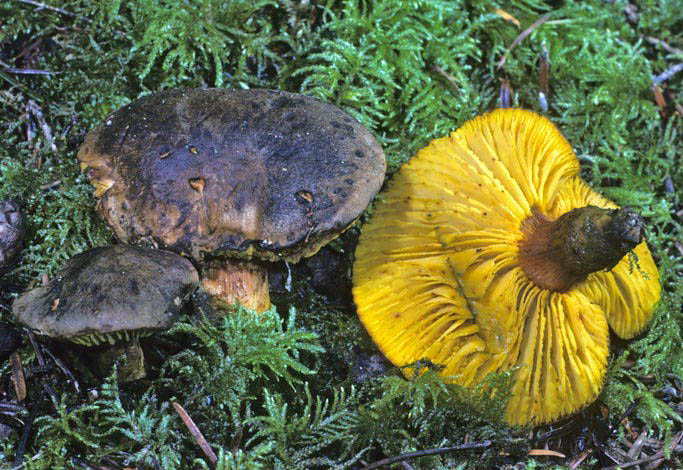
© Kit Scates Barnhart
Danny’s DNA Discoveries – gilled boletes of the PNW
by Danny Miller
|
|
Danny’s DNA Discoveries – gilled boletes of the PNW
|
|
Introduction
Gilled boletes are in the order Boletales, more closely related to boletes than they are to most other gilled mushrooms which are found in the Agaricales. In fact, Phylloporus, the original gilled bolete, was one of the first mushrooms to teach mycologists that their morphologic classification system might not reflect their natural relationships. It was easy to assume that gilled and pored and spiny mushrooms belonged together with others like them. But when they first looked at the "gilled bolete", shown above, with its colour and stature exactly matching a number of boletes with a dark cap and bright yellow pores, and they turned it upside down, they found gills instead of pores. When the microscope was invented, they found it produced spores over twice as long as they are wide, just likes boletes do. Then they knew something was up and that mushrooms must have evolved back and forth between gills and pores more than once. As it turns out, it's not that big a change. Imagine pinching two gills together at regular intervals and you are creating pores. As as the DNA era has shown, convergent evolution (the same look coming about independently) is quite common. But Phylloporus was one the first clues. Since then the microscope discovered that other mushrooms seemed to be bolete relatives, and DNA has confirmed it. You'll just have to learn how to recognize the various genera, but there is often a clue - gills that (especially near the stem) do something weird (after all, they didn't evolve with other gilled mushrooms) - either fork, wriggle, or become interveined almost to the point that they might start to look like pores where they attach to the stem. I will also cover false truffles in the gilled bolete families. abundant common uncommon rare - colour codes match my Pictorial Key and are my opinions and probably reflect my bias of living in W WA. Rare species may be locally common in certain places at certain times. |
|
Summary of Interesting Results
Here are some of the newest, most interesting results of the study:
|
 Phylloporus - click to expand Phylloporus - click to expand
Boletaceae - These are very closely related to Xerocomus boletes, in fact it's not certain if they belong in Xerocomus or deserve their own genus. Their ITS sequences can be strange, with multiple copies of some portions, slightly modified, making them hard to align. Both ITS1 and ITS2 are each about 750 bp long, usually that is the size of combined ITS. This means that when sequencing a gene that is expected to be a total of 750 long, the forward read will usually only get ITS1 and the reverse read will usually only get ITS2, which you will have to combine by hand. Expect sequences of this genus that are not specially handled to be only a portion of one of the two ITS regions. Dark cap and bright yellow... gills, looking like so many true boletes with the same colour and stature. Species mentioned: Phylloporus rhodoxantha, arenicola |
 Hygrophoropsis - click to expand Hygrophoropsis - click to expand
Hygrophoropsidaceae - Commonly mistaken for a chanterelle by beginners, so therefore one of our "false chanterelles" with an orange cap and strongly decurrent bright orange forked gills. The caps on some species may be dark brown or even pale (almost white). Species mentioned: Hygrophoropsis aurantiaca, rufa, pallida |
 Gomphidius and Chroogomphus - click to expand Gomphidius and Chroogomphus - click to expand
Gomphidiaceae - Easily recognized fairly large, fleshy mushrooms with strongly decurrent gills and grey to black spores. Gomphidius are very slimy with white flesh that blackens. Chroogomphus are not slimy and have orange coloured flesh with water soluble pigments that can turn your urine red like beets. Chroogomphus albipes CA and Chroogomphus loculatus OR are secotioids. Gomphogaster leucosarx is a trufflized mushroom in this family. Species mentioned: Gomphidius glutinosus, largus, oregonensis, maculatus, pseudomaculatus, smithii, subroseus. Chroogomphus tomentosus, vinicolor subsp. californicus, ochraceus, pseudovinicolor, leptocystis, albipes, loculatus. Gomphogaster leucosarx. |
 Paxillus, Alpova and Melanogaster - click to expand Paxillus, Alpova and Melanogaster - click to expand
Paxillaceae - Large but thin-fleshed mushrooms with indented caps, a strongly inrolled margin, strongly decurrent gills that are often easily separable from the cap flesh and brown spores. The caps are large, yellow- to olive-brown discs and the mushrooms strongly stain brown. Alpova and Melanogaster are trufflized mushrooms in the same family. Some ITS only trees show that Alpova is indeed a separate genus from Melanogaster, but it doesn't always show up that way. However, a 3-gene study was able to confirm with high confidence that Alpova is monophyletic and distinct. Species mentioned: Paxillus involutus, cuprinus, ammoniavirescens, obscurisporus. Alpova diplophloeus, concolor, trappei. Melanogaster tuberiformis, macrocarpus, euryspermus, natsii, ambiguus, intermedius, broomianus, vittadinii. |
 Tapinella - click to expand Tapinella - click to expand
Tapinellaceae - formerly these were all in Paxillus, because they too often have forked or interviened gills easily separable from the cap flesh. Tapinella atrotomentosa EU - very large dark brown cap with strongly decurrent yellowish gills and a large, black-velvet eccentric stem on conifer stumps. Brown spores. Tapinella panuoides EU - lacks a stem, on conifer stumps with brown spores. Yellowish brown cap and gills. The cap can be hairy when young. Hard to differentiate from Crepidotus except for the odd forked, crimped (wrinkled) or interveined gills near the point of attachment). |